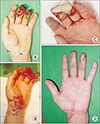Abstract
Purpose
The reconstruction of posttraumatic fingertip defects requires adequate soft tissue coverage, sensibility and minimal donor site morbidity. Reconstruction is more difficult in the case of multiple fingertip defects. The purpose of this study was to report the results of reconstruction of multiple fingertip defects using the innervated radial artery superficial palmar branch perforator flap (iRASP).
Methods
We performed 19 cases of the iRASP for the reconstruction of multiple fingertip defects. The surgery was performed in two stages. In the first stage, defects were covered with the iRASP. In the second stage, the flap was divided 2–3 weeks after the first operation.
Results
All flaps survived. At the last follow-up, static two-point discrimination was measured. A mean of 7.6 mm (6–9 mm) was measured on the affected side and 3.6 mm (2–5 mm) on the contralateral side. The sensory examination was performed at a mean 6.8 months (4–11 months) after surgery. Postoperatively, some patients complained of pain in the donor scars, but most of them disappeared after six months. Debulking surgery was not needed to improve the contours.
Conclusion
We reconstructed multiple fingertip defects using the iRASP, and obtained satisfactory functional and cosmetic results. Four fingertip defects could be reconstructed with one flap and with satisfactory sensory recovery. Therefore, the iRASP is considered an appropriate treatment for reconstruction of multiple fingertip defects.
Figures and Tables
 | Fig. 1(A) A 43-year-old male with a skin defect of the left 3rd, and 4th fingers caused by a crushing injury. (B) Flap design. (C) Flap insetting. (D) Postoperative photo, six months after surgery (informed consent was taken). |
References
1. Lee SH, Cheon SJ, Kim YJ. Clinical application of a free radial artery superficial palmar branch flap for soft tissue reconstruction of digital injuries. J Hand Surg Eur Vol. 2017; 42:151–156.
2. Lee DC, Kim JS, Ki SH, Roh SY, Yang JW, Chung KC. Partial second toe pulp free flap for fingertip reconstruction. Plast Reconstr Surg. 2008; 121:899–907.

5. Thoma A, Vartija LK. Making the V-Y advancement flap safer in fingertip amputations. Can J Plast Surg. 2010; 18:e47–e49.

6. O'Brien B. Neurovascular island pedicle flaps for terminal amputations and digital scars. Br J Plast Surg. 1968; 21:258–261.
7. Cohen BE, Cronin ED. An innervated cross-finger flap for fingertip reconstruction. Plast Reconstr Surg. 1983; 72:688–697.

8. Buncke HJ, Rose EH. Free toe-to-fingertip neurovascular flaps. Plast Reconstr Surg. 1979; 63:607–612.

9. Logan A, Elliot D, Foucher G. Free toe pulp transfer to restore traumatic digital pulp loss. Br J Plast Surg. 1985; 38:497–500.

10. Tan H, Luo X, Yang K, Jiang J, Wei P, Zhao J. Repair of minor tissue defect in hand by transfer of free tissue flap from the toe. Arch Bone Jt Surg. 2014; 2:11–16.
11. Melone CP Jr, Beasley RW, Carstens JH Jr. The thenar flap--an analysis of its use in 150 cases. J Hand Surg Am. 1982; 7:291–297.

12. Chi Z, Yang P, Song D, et al. Reconstruction of totally degloved fingers: a novel application of the bilobed spiraled innervated radial artery superficial palmar branch perforator flap design provides for primary donor-site closure. Surg Radiol Anat. 2017; 39:547–557.

13. Javaid M, Cormack GC. Anterolateral thigh free flap for complex soft tissue hand reconstructions. J Hand Surg Br. 2003; 28:21–27.

14. Tsai TM, Sabapathy SR, Martin D. Revascularization of a finger with a thenar mini-free flap. J Hand Surg Am. 1991; 16:604–606.

15. Kamei K, Ide Y, Kimura T. A new free thenar flap. Plast Reconstr Surg. 1993; 92:1380–1384.
16. Omokawa S, Mizumoto S, Iwai M, Tamai S, Fukui A. Innervated radial thenar flap for sensory reconstruction of fingers. J Hand Surg Am. 1996; 21:373–380.
17. Sassu P, Lin CH, Lin YT, Lin CH. Fourteen cases of free thenar flap: a rare indication in digital reconstruction. Ann Plast Surg. 2008; 60:260–266.
18. Bilge O, Pinar Y, Ozer MA, Gövsa F. A morphometric study on the superficial palmar arch of the hand. Surg Radiol Anat. 2006; 28:343–350.

19. Iwuagwu FC, Orkar SK, Siddiqui A. Reconstruction of volar skin and soft tissue defects of the digits including the pulp: experience with the free SUPBRA flap. J Plast Reconstr Aesthet Surg. 2015; 68:26–34.

20. Yang JW, Kim JS, Lee DC, et al. The radial artery superficial palmar branch flap: a modified free thenar flap with constant innervation. J Reconstr Microsurg. 2010; 26:529–538.

21. Sakai S. Free flap from the flexor aspect of the wrist for resurfacing defects of the hand and fingers. Plast Reconstr Surg. 2003; 111:1412–1420. discussion 1421-2.

22. Han SK, Lee BI, Kim WK. The reverse digital artery island flap: clinical experience in 120 fingers. Plast Reconstr Surg. 1998; 101:1006–1011. discussion 1012-3.





 PDF
PDF ePub
ePub Citation
Citation Print
Print







 XML Download
XML Download